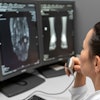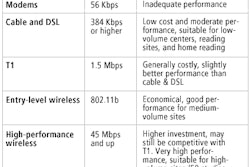"People are always blaming their circumstances for what they are. I don't believe in circumstances. The people who get on in the world are the people who get up and look for the circumstances they want, and if they can't find them, make them." -- George Bernard Shaw, Mrs. Warren’s Profession.
Radiologists dealing with the U.S. Hospital Outpatient Prospective Payment System (HOPPS) might disagree with Shaw. To be sure, HOPPS bears all the markings of a confining set of circumstances forced on radiologists by an outside agency, in this case the federal government. And each time radiologists begin to understand the system, new provisions appear to increase its complexity.
But it's not enough to simply complain about HOPPS, according to a recent review in Radiology Online. According to the authors, if radiologists hope to make substantive changes in the payment system, they'll have to start directing their complaints to the people who can do something about them.
In the August 26 article, Dr. John Smith, from the department of radiology, and attorneys Anthony Maida and Jennifer Henderson, all from Massachusetts General Hospital in Boston, tracked the evolution of HOPPS and offered insight on its implications for radiologists.
"The CMS (Centers for Medicare and Medicaid Services) has demonstrated a definite willingness to work with the stakeholder community to reach workable solutions to problems arising from the current hospital OPPS," the authors wrote. "However, the agency only responds to those issues of which it is aware, and depends heavily on third parties to bring problem areas to its attention."
Of particular concern to radiologists is how the system will affect radiology practice and the introduction of new technology and services to the outpatient setting. In response to the high cost associated with the introduction of a new device, the Balanced Budget Refinement Act created an ambulatory patient classification (APC) group designed to accurately reimburse new technologies.
The goal is for a hospital to receive 95% of the average wholesale price of the charge for a device, adjusted to cost. However, payments made under these pass-through provisions are limited by the Balanced Budget Refinement Act to 2.5% of the total payments made under HOPPS.
The article lists eight criteria that a new product or service must meet to be eligible for the CMS to consider it for transitional pass-through payments. But these only apply to outpatient technologies introduced prior to HOPPS implementation and not billable to Medicare before January 1, 1997.
Beginning next year, new outpatient technologies and services introduced after HOPPS implementation (April 7, 2000) will have to meet all eight CMS criteria, and will also have to leap a new reimbursement hurdle.
"After the first of the year, the expected reasonable cost of a product must exceed by 25% the portion of fee schedule with which it is associated, and the difference between the reasonable cost of the product and its portion of the fee schedule must exceed 10% of the total fee-schedule reimbursement for the service," the article states.
However, just because a new product meets the criteria for pass-through payment doesn't necessarily mean it will qualify for Medicare coverage. It can be denied by CMS on a national level, or via a local coverage decision by a CMS contractor, according to the authors. If a service or product is denied for outpatient use under HOPPS, it has a direct impact on how and where radiology services are conducted.
"For instance, a decision on the part of CMS to classify a particular service as ineligible for outpatient reimbursement has the potential to dictate the setting where radiology services are provided, regardless of what a radiologist may believe is medically appropriate for a given patient," the authors wrote. "Simply put, if CMS does not consider a particular service eligible for outpatient reimbursement, that service will likely not be provided in the outpatient setting."
The structure of HOPPS might even drive hospital-based institutions to divest themselves of outpatient radiology departments, according to the authors. As the system affects only a hospital’s wholly owned outpatient centers, and does not apply to partially hospital-affiliated outpatient facilities such as freestanding or physician office-based imaging centers, facilities only partially owned by hospitals will not face the same fixed rates applied to hospital facilities providing identical services. Over time, this may drive patient care to the environment offering the provider the greatest financial advantage.
For radiologists trying to practice the best medicine possible, HOPPS may create financial incentives and disincentives for the ordering of a particular service on a specific modality. The authors point out that certain CT procedures performed with contrast may actually yield increased technical reimbursement under the new system, while reimbursement for many MR procedures is lowered.
The authors fear that this will create a tail-wagging-the-dog situation, where a hospital will encourage the use of one modality versus another in order to maximize its Medicare reimbursement.
Also at issue is the almost Byzantine complexity of the reimbursement scheme. Beneficiary copayments, transitional pass-through payments, outlier, and transitional-corridor payments may all figure into the reimbursement mix, depending on the product or service used.
The cost of accounting for these payment types is not unsubstantial, and with each layer of reimbursement, the possibility of billing errors increases. Underbilling will leave money on the table, and overbilling will bring the Office of the Inspector General knocking on the door. Neither option is palatable to any institution working to keep its doors open.
Finally, the authors foresee HOPPS creating a system that excludes Medicare beneficiaries from medical advances available to the general U.S. population.
"Perhaps the greatest concern lies with the ultimate effect of the new system on the development and broad clinical application of innovative image-based procedures and services that have had such a positive effect on the health and quality of life of Medicare patients. Simply put, if Medicare does not provide adequate technical reimbursement for new medical products and services and make coverage and reimbursement determinations for them in a timely manner, it is unlikely that Medicare beneficiaries will receive such services," they cautioned.
Like it or not, HOPPS is not going to go away. However, the onerous aspects of the system can be changed via radiologist advocacy, both personally by contacting CMS during public comment periods on HOPPS reimbursement rates (generally, late August through early October each year) and through professional societies such as the American College of Radiology of Reston, VA.
"By productively engaging CMS, the radiology community can positively influence the continuing evolution of the hospital OPPS and its impact on our profession. By doing so, we can ensure continued access to high-quality radiology services for our Medicare patients and the community beyond," the authors concluded.
By Jonathan S. BatchelorAuntMinnie.com staff writer
September 12, 2002
Related Reading
CMS’ proposed 2003 payment rates bode ill for breast procedures, August 12, 2002
Decrease proposed for 2003 PET APC reimbursement, August 12, 2002
Hospitals say Medicare rate hike falls short, May 10, 2002
New HOPPS rates bring PET reimbursement hike, March 4, 2002
Copyright © 2002 AuntMinnie.com


















